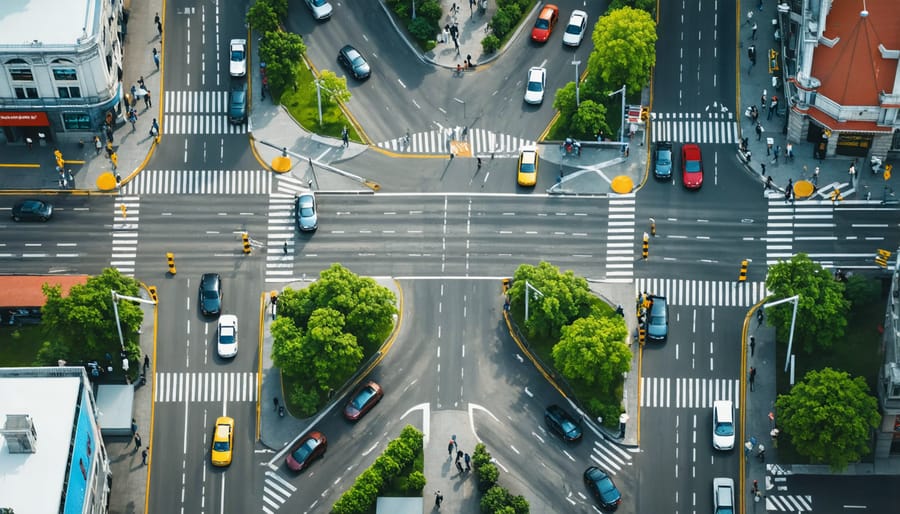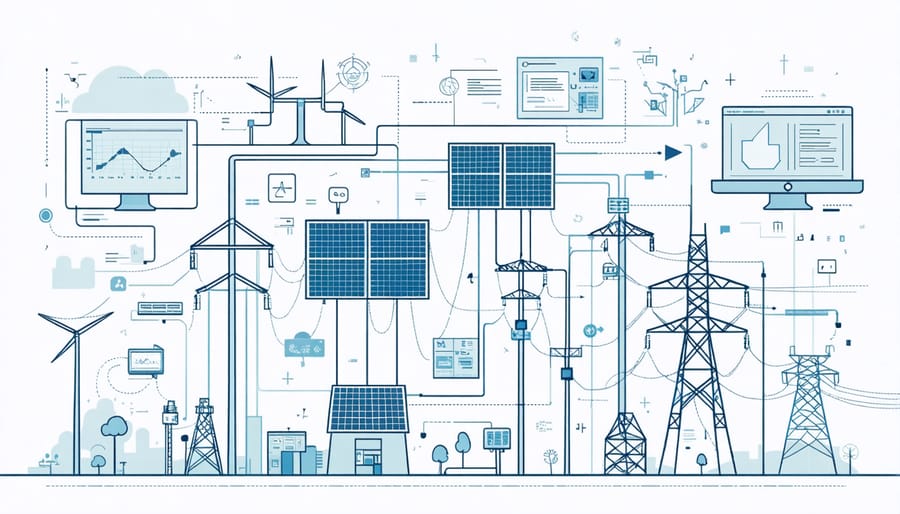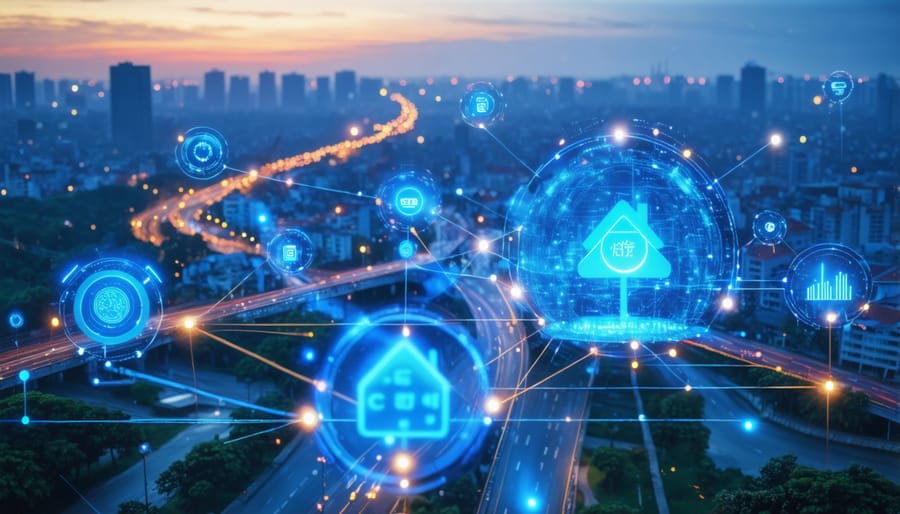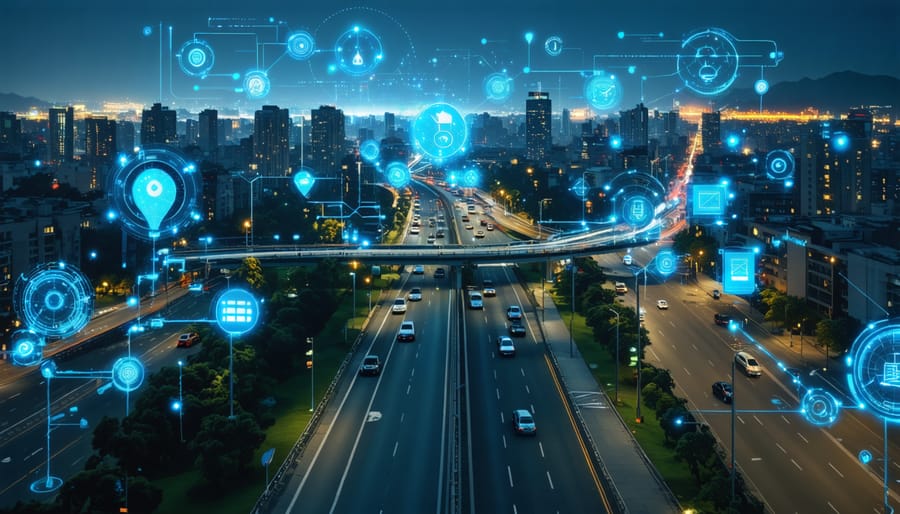Smart cities are revolutionizing urban infrastructure through data-driven systems and interconnected technologies, delivering unprecedented efficiency and sustainability in modern metropolitan areas. From Amsterdam’s autonomous vehicle networks to Singapore’s comprehensive sensor systems, these innovations are reshaping how cities operate, serve citizens, and manage resources.
Leading examples demonstrate the transformative power of smart infrastructure integration. Barcelona’s smart lighting system has reduced energy consumption by 30% while improving public safety. Copenhagen’s intelligent traffic management has cut average commute times by 15% and decreased carbon emissions significantly. Meanwhile, Seoul’s comprehensive waste management system uses IoT sensors to optimize collection routes and reduce operational costs by 40%.
These implementations showcase how smart city infrastructure combines cutting-edge technology with practical urban planning to address critical challenges. As cities worldwide face increasing populations and environmental pressures, these solutions provide scalable, data-driven frameworks for sustainable urban development. The most successful examples share common elements: robust digital infrastructure, integrated data platforms, and clear metrics for measuring impact and return on investment.
These real-world applications offer valuable blueprints for municipalities seeking to modernize their infrastructure while improving quality of life and operational efficiency.
Transportation and Mobility Solutions
Intelligent Traffic Management Systems
Modern Intelligent Traffic Management Systems (ITMS) represent one of the most impactful smart mobility solutions implemented in urban environments today. The city of Singapore exemplifies this through its advanced traffic control network, which combines AI-powered cameras, sensors, and adaptive traffic signals to reduce congestion by 20% during peak hours.
In Barcelona, the implementation of smart traffic lights equipped with machine learning algorithms has decreased emergency response times by 25%. The system automatically creates green corridors for emergency vehicles while optimizing regular traffic flow. Sensors embedded in the road infrastructure collect real-time data on traffic density, vehicle speed, and pedestrian movement, enabling dynamic adjustments to signal timing.
Stockholm’s traffic management system demonstrates the integration of weather sensors with traffic controls, automatically adjusting signal patterns during adverse conditions. This adaptive approach has reduced weather-related accidents by 30% and improved overall traffic flow efficiency by 15%.
These systems typically incorporate:
– Real-time traffic monitoring through IoT sensors
– AI-powered predictive analytics for traffic pattern optimization
– Automated incident detection and response
– Dynamic message signs for real-time driver information
– Integration with public transportation systems
The success of these implementations highlights the crucial role of comprehensive data integration and automated decision-making in modern urban traffic management.

Connected Public Transit Networks
Modern smart cities are revolutionizing public transit through integrated networks that combine multiple transportation modes with advanced digital infrastructure. Singapore’s Land Transport Authority (LTA) exemplifies this approach with its unified payment system, allowing seamless transitions between buses, metros, and light rail using contactless cards or mobile devices. The system processes over 7.5 million trips daily, with real-time capacity monitoring and dynamic route optimization.
Copenhagen’s Intelligent Transport System (ITS) demonstrates how connected infrastructure can prioritize public transit. Smart traffic signals automatically adjust timing to favor approaching buses and trains, reducing travel times by 15-20%. The city’s integrated mobility platform provides real-time updates across all transport modes, enabling commuters to make informed decisions about their journeys.
Hong Kong’s Octopus system serves as another prominent example, handling over 14 million transactions daily across its transit network. The system’s smart sensors track vehicle locations, passenger volumes, and service disruptions, enabling operators to optimize fleet management and maintenance schedules. Digital displays at stations and stops provide accurate arrival predictions, while mobile apps offer personalized route planning and fare calculations.
These implementations showcase how connected transit networks can improve operational efficiency while enhancing the passenger experience. Key success factors include robust data infrastructure, standardized payment systems, and comprehensive integration across different transport modes.
Energy Management Infrastructure

Smart Grid Technologies
Modern cities are increasingly implementing smart grid technologies to optimize power distribution and consumption. Copenhagen’s intelligent grid system, for instance, has achieved a 30% reduction in energy wastage through real-time monitoring and automated load balancing. The system employs advanced metering infrastructure (AMI) that enables two-way communication between utilities and consumers, facilitating dynamic pricing and demand response programs.
In Singapore, the Power Grid 2.0 initiative demonstrates how intelligent power systems can integrate renewable energy sources seamlessly. The system utilizes artificial intelligence to predict consumption patterns and automatically adjusts distribution based on real-time demand. Solar integration has improved by 40% since implementation, while grid reliability has reached 99.999%.
Tokyo’s smart grid implementation showcases innovative fault detection and self-healing capabilities. When power outages occur, the system automatically reroutes electricity through alternative pathways, reducing downtime by 65%. Additionally, the grid’s predictive maintenance protocols have decreased maintenance costs by 25% while extending infrastructure lifespan.
These successful implementations demonstrate how intelligent power distribution systems not only enhance efficiency but also improve grid resilience and sustainability. Key features include advanced sensors, automated switching systems, and sophisticated data analytics platforms that enable proactive grid management and optimization.
Building Energy Management
Building Energy Management Systems (BEMS) represent a cornerstone of smart city infrastructure, enabling significant reductions in energy consumption and operational costs while enhancing occupant comfort. These systems integrate advanced sensors, IoT devices, and AI-powered analytics to optimize energy usage across commercial and residential buildings.
Modern BEMS implementations typically incorporate three key components: real-time monitoring, automated control systems, and predictive maintenance capabilities. Sensors throughout the building track occupancy patterns, temperature variations, and lighting conditions, while smart meters monitor energy consumption at granular levels. This data feeds into central management platforms that automatically adjust HVAC systems, lighting, and other building systems for optimal efficiency.
Notable examples include the Edge building in Amsterdam, which achieved a 98% reduction in energy consumption through its network of 28,000 sensors and intelligent building management system. Similarly, the Capital Tower in Singapore utilizes AI-driven BEMS to reduce energy usage by 35% while maintaining optimal comfort levels for occupants.
Implementation strategies typically follow a phased approach:
– Installation of smart meters and sensors
– Integration with existing building management systems
– Deployment of automation protocols
– Implementation of predictive maintenance algorithms
– Continuous optimization based on usage patterns
The return on investment for BEMS typically materializes within 2-3 years, with energy savings ranging from 20% to 40% in most commercial applications.
Digital Communication Networks
5G Implementation
The implementation of 5G urban connectivity solutions has transformed several metropolitan areas into highly efficient smart cities. Barcelona stands as a prime example, having deployed over 200 5G small cells across its urban core, achieving coverage speeds of up to 1.5 Gbps while reducing network latency to below 10 milliseconds. This infrastructure supports real-time traffic management and emergency response systems throughout the city.
Singapore’s Smart Nation initiative showcases another successful 5G implementation, with the city-state achieving 95% outdoor coverage through strategic placement of 5G nodes integrated with existing street furniture. The network enables advanced IoT applications, including automated waste management and intelligent lighting systems that have reduced energy consumption by 30%.
In South Korea, Seoul’s comprehensive 5G network spans 85% of the city, supporting everything from autonomous vehicle testing to AR-enhanced public services. The deployment includes specialized indoor solutions for high-density areas and underground transportation hubs, ensuring seamless connectivity across the urban landscape.
These implementations demonstrate how strategic 5G deployment can serve as the backbone for smart city operations, enabling data-driven decision-making and improved urban services.
IoT Sensor Networks
IoT sensor networks form the nervous system of modern smart cities, collecting real-time data through strategically placed sensors across urban environments. Leading cities have implemented comprehensive sensor networks that monitor various environmental and infrastructural parameters. For instance, Barcelona’s sensor network encompasses over 19,500 smart meters monitoring water consumption and irrigation systems, while also tracking air quality and noise levels throughout the city.
Copenhagen’s intelligent lighting system utilizes motion sensors and ambient light detectors across 20,000 street lights, reducing energy consumption by 65% while maintaining optimal illumination levels. Similarly, Singapore’s Smart Nation initiative deploys sensors monitoring everything from waste management to structural health of buildings and bridges.
These citywide sensor deployments enable predictive maintenance of infrastructure, optimize resource allocation, and enhance public safety. Amsterdam’s smart traffic management system employs a network of cameras and sensors to monitor traffic flow and adjust signal timing in real-time, reducing average journey times by 20%.
In Los Angeles, smart parking sensors help drivers locate available spaces quickly, reducing traffic congestion and emissions from cars circling for parking. The data collected through these sensor networks provides valuable insights for urban planning and infrastructure development, enabling data-driven decision-making for city administrators.
Waste Management and Environmental Monitoring
Smart Waste Collection Systems
Modern smart waste management systems are revolutionizing how cities handle waste collection and disposal through IoT-enabled solutions. These systems utilize sensors embedded in waste containers to monitor fill levels, temperature, and waste composition in real-time. When containers reach predetermined capacity thresholds, the system automatically alerts collection teams, optimizing route planning and reducing unnecessary pickups.
Cities like Barcelona and Copenhagen have implemented these solutions with remarkable results, achieving up to 30% reduction in collection costs and 60% decrease in truck routes. The systems typically integrate GPS tracking, route optimization algorithms, and data analytics platforms to streamline operations. Sensors can detect various parameters, including waste volume, weight, and potential hazards, ensuring efficient sorting and proper handling of different waste types.
Key benefits include reduced carbon emissions from collection vehicles, improved urban hygiene, and significant cost savings in operational expenses. The collected data enables cities to analyze waste generation patterns, optimize bin placement, and implement targeted waste reduction programs. Advanced systems also incorporate solar-powered compactors that increase bin capacity by up to five times, reducing collection frequency and associated costs.
These smart solutions are particularly effective in high-density urban areas, where traditional waste collection methods often struggle with efficiency and timing. Real-world implementations have demonstrated return on investment within 18-24 months through operational savings and improved resource allocation.
Environmental Monitoring Networks
Environmental monitoring networks form a critical component of smart city infrastructure, utilizing advanced sensor technology to deliver real-time data on air quality, pollution levels, and environmental conditions. These systems typically comprise interconnected nodes positioned strategically throughout urban areas, each equipped with multi-parameter sensors measuring particulate matter (PM2.5 and PM10), nitrogen dioxide, carbon monoxide, and other key pollutants.
Cities like Copenhagen and Singapore have implemented comprehensive monitoring networks that integrate with their broader smart city platforms. Copenhagen’s Air Quality Monitoring System features over 200 sensor points across the city, enabling authorities to make data-driven decisions about traffic management and urban planning based on pollution patterns.
The effectiveness of these networks lies in their ability to process and analyze data in real-time. Advanced algorithms detect unusual patterns and trigger automated responses, such as adjusting traffic signals to reduce congestion in areas with elevated pollution levels. Many systems also incorporate weather data and predictive analytics to forecast potential air quality issues.
Implementation costs typically range from $500,000 to $2 million, depending on network scale and sensor sophistication. However, the return on investment is substantial, with cities reporting 15-30% improvements in air quality management efficiency and significant reductions in response times to environmental incidents. These networks also support public health initiatives by providing citizens with immediate access to air quality information through mobile applications and digital displays.

As we look toward the future of urban development, smart city infrastructure continues to evolve at an unprecedented pace. The integration of IoT sensors, AI-driven analytics, and interconnected systems is reshaping how cities function and serve their residents. Industry experts project that by 2030, smart city technologies will drive over $2.5 trillion in economic benefits globally through improved efficiency, sustainability, and quality of life.
The transformation of urban infrastructure is increasingly focused on resilience and adaptability. Cities are moving beyond isolated smart solutions toward comprehensive ecosystem approaches, where different systems communicate and work together seamlessly. This integration enables more sophisticated responses to urban challenges, from traffic management to emergency services coordination.
Data-driven decision making will become the cornerstone of urban planning and operations. Advanced analytics and machine learning algorithms will enable predictive maintenance of infrastructure, optimize resource allocation, and enhance public services delivery. The emergence of digital twins – virtual replicas of physical infrastructure – will revolutionize how we plan, build, and maintain urban systems.
Looking ahead, the success of smart city initiatives will depend heavily on collaboration between public and private sectors, standardization of technologies, and robust cybersecurity measures. The focus will shift from implementing individual smart solutions to creating sustainable, inclusive cities that prioritize citizen well-being and environmental stewardship.
For construction professionals and urban planners, this evolution presents both challenges and opportunities. The demand for expertise in smart infrastructure implementation will grow, requiring new skills and approaches to project delivery. As cities worldwide embrace these technologies, the lessons learned from current implementations will prove invaluable in shaping the future of urban development.

